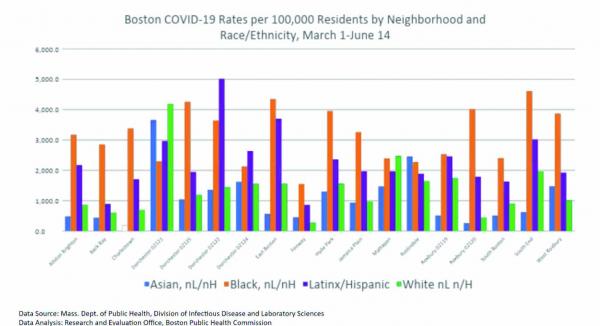November 5, 2020

Boston officials are developing new measures that will be implemented over the next 60 days in response to a steady increase in the citywide positive Covid-19 test rate over the last five weeks.
Dorchester posted the highest test rate last week, at 11.9 percent, well above the citywide average of 7.9 percent. And Mattapan was second highest, at 10.9 percent.
“It’s been five consistent weeks that we are seeing these numbers go up, which is concerning,” Mayor Walsh said during a press conference last Thursday in City Hall. “The focus now must be to turn around this trend and we are definitely seeing a trend now.”
Marty Martinez, the city’s chief of Health and Human Services, joined Boston Public Health Commission (BPHC) officials in a press roundtable on Friday to brief reporters on the steps the city is looking at to combat the trend.
The BPHC’s most recent data show that the citywide average positive test rate increased from 6 percent the prior week (Oct. 11-17) to 7.8 percent last week (Oct. 18-24). Dorchester zip codes 02122 and 02124 posted the city’s highest positivity rate at 11.9 percent, with 02121 and 02125 at 10.1 percent.
A breakdown of Covid rates per 100,000 residents by neighborhood and race/ethnicity from June 15 to Oct. 22 shows that Latinx populations in Dorchester zip codes are among the highest in the city.
The same dataset from March 1 to June 14 shows that rates were disproportionately high among Black and Latinx communities in neighborhoods citywide.
“It’s not just one neighborhood or one area. It has cut across all of our neighborhoods in many different ways,” said Martinez. “This data has been really centrally important to us to target initiatives, outreach, and efforts within specific neighborhoods, which has been key.”
“In the earlier months,” he said, “you see that the Black community in almost every neighborhood was the hardest hit. There was definitely a disproportionate impact. We’ve seen progress in this community in terms of the number of new infections; however still much work needs to be done with the increase in the Latinx community and our vulnerable populations.”
Said BPHC Executive Director Rita Nieves: “Covid has been experienced unequally throughout our neighborhoods and especially those that have large percentages of Black and other people of color and immigrant residents. Our Black and Latinx residents have consistently accounted for above 30 percent of our cases.”
The city’s health data also shows a reduction in recent months in the number of Covid cases and mortalities in Black communities, but a steady increase in those rates in the Latinx community.
“Our goal will continue to be to focus on the inequitable impact of the virus in our neighborhoods,” said Nieves.
“We have lessons learned and things that we can continue to use to guide how we prepare if we do end up with a steady increase in our numbers going into the winter.”
Dr. Jennifer Lo, medical director at the BPHC, shared some trends that health officials are noticing through case investigations and contact tracing when it comes to what types of scenarios lead to exposure.
“The information coming from our case investigations indicates a lot of the cases we see that potentially could be spreaders are some small group gatherings of 3 to 4 people,” she said. “But then people might have group gatherings every day of the week with others which generate 25 contacts and that’s similar to having one larger party. That repeated social activity can increase the number of positive cases from one positive person.”
In workplace settings, she added, the most common way that people are coming into contact with the virus are “break room gatherings.” The city plans to expand testing ability citywide and increase usage; increase outreach to targeted populations and neighborhoods with high infection rates; provide isolation support; support Boston hospitals; expand contact tracing and improving testing turnaround times; assess how public health data are analyzed; and increase enforcement measures.
The city will also publish a bi-weekly report on case investigation information that indicates specific issues and patterns that show where and how people are being exposed to the virus. Officials will work with state partners to monitor lab result turnaround times to ensure that wait times are no longer than 72 hours.


